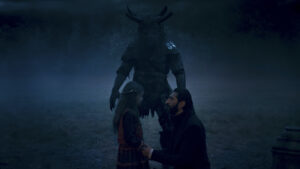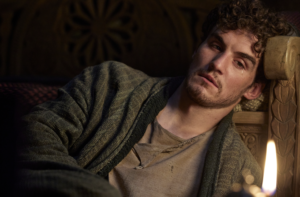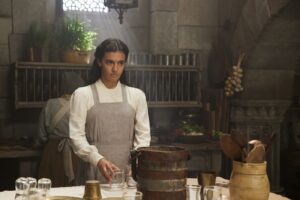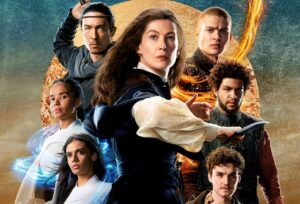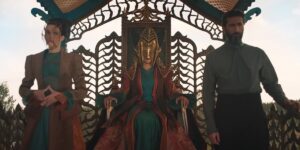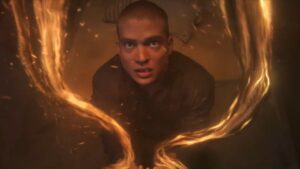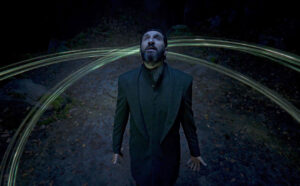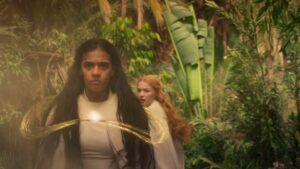MINOR SPOILERS FOR THE WHEEL OF TIME, SEASON 2, EPISODES 1 – 3 AHEAD!
This piece was written during the 2023 WGA and SAG-AFTRA strikes. Without the labor of the writers and actors currently on strike, the series being covered here wouldn’t exist.
“The Wheel doesn’t want anything. It can’t. Any more than a river or the rain can want something. It’s people who want.”
Those words, spoken in The Wheel Of Time‘s first season by Moiraine Damodred (Rosamund Pike) in rebuttal to Logain Ablar (Álvaro Morte)’s whimpered insistence that the Wheel “wanted” him to be the Dragon and the carnage he left in his wake was therefore unavoidable, have never sat right with me, and I think I have finally found the words to explain why while mulling over the events of the second season’s second episode, Strangers And Friends, which brings each of the main characters to something of a turning-point in their respective arcs where they realize that all the “wanting” in the world will avail to nothing if the Wheel of Time never gives them opportunities to assert their agency in the first place, and the Pattern, the complex product of the Wheel’s endless turnings, is practically inescapable for those unlucky individuals called ta’veren who find themselves woven into positions where they are responsible for holding the Pattern intact through the duration of a crisis. Even if they were somehow able to make a choice of their own free will, they would never know, because the Wheel would simply course-correct and keep turning. The Wheel doesn’t want, it can’t, but it was set in motion for a purpose by its Creator, and it will serve that Creator’s purpose as long as it is not prevented from doing so by the Dark One.
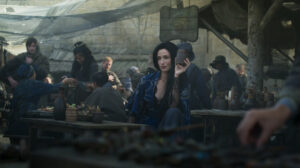
For some, like Logain, fate has convenience as a shield, an excuse for dark deeds, but accepting foregone conclusions is not in our human nature, and most of us would become enraged or inconsolable if we could analyze our every action to discern which we made freely and which were made for us with the express purpose of guiding us to an end – and we don’t even live in a universe where a Wheel of cosmic proportions periodically requires something of us, at least not as far as we know. And maybe it’s for the best that we remain blissfully unaware of our metaphysical surroundings, because for Rand al’Thor (Josha Stradowski) it’s the knowing, as much as the impending madness brought on by channeling the tainted male half of the One Power, that has him on the verge of collapsing every day.
As Rand sees it, the Pattern should be done with him. He defeated the Dark One at the Eye of the World, and Moiraine let him leave so he could safely isolate himself from his friends before going mad and killing himself, as he was sure he would, sooner or later, when he first touched the True Source and felt the madness clawing into his head. And yet…five months later, he’s still alive, still mostly sane, and still haunted by recurring nightmares of the man he believed to be the Dark One, but was actually Ishamael (Fares Fares), strongest of the channelers derisively named Forsaken who served the Dark One before the Breaking of the World. The Rand we meet in episode two is one who is still just tentatively starting to accept that he might have been granted a few more months, weeks, or days in the world to do some good, and is now realizing he doesn’t want to work up the courage to face madness and death a second time. But the harder he fights to bring his powers under control, the more the madness grows within him. And no one can help him, not even the enigmatic innkeeper Selene (Natasha O’Keefe) who sidles up to him in his moments of doubt.
What Selene offers Rand, however, is the physical affection he desperately craves but wouldn’t dare to ask for from anyone he truly cares about. Although their arrangement is sexual in nature, it is not exactly a romance, and I’m surprised (but then again, not really) that some reviewers interpreted it as one when The Wheel Of Time goes to great lengths to make it evident that Rand is with Selene for reasons of his own, and vice versa. Now, there is a moment in episode two during a candid conversation between the two where something in Selene’s eyes suggests she’s disappointed in Rand when he admits he’s only with her to try and forget someone else, but she merely sighs and assures him that if that’s the way it has to be, then she’ll gladly help him to forget. She confesses to fantasizing he’s someone different as well, someone she wants to remember. Will we ever get clarification on that? Perhaps.
In the meantime, Rand begins working his way through the ranks of the caretaking staff at a depressingly decorated sanatorium in Cairhien that houses patients from all over the Westlands, including veterans of the local Aiel War and male channelers gentled by the Red Ajah. As we soon discover, it is also where Logain has been residing for the past several months; not at the White Tower, as in Robert Jordan’s books, which means the fan-favorite character may play a different role in the story going forward, but the explanation given in the show is that Logain comes from an exceptionally wealthy and influential family in Ghealdan (canonically accurate), and they arranged more comfortable accommodations for him to live out his last days, still watched day in and day out as Siuan vowed he would be, but free to swagger about the gardens and boast that he used to be a Dragon. Rand’s only hope for enduring the madness or avoiding it altogether now rests with Logain, certifiably a madman.
To my surprise, the tender scenes between Rand and an elderly patient at the sanatorium (played by Nasser Memarzia) did far more to engage me in his storyline than any amount of watching him grapple with the Power after leaving a generic bully lying bloodied in an alleyway, though I feel it’s a matter of personal preference and Stradowski being at his most convincing when his Rand has a faint remnant of his sweetly rugged former self to cling to and build around.
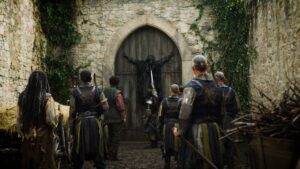
On the other side of the world, Perrin Aybara (Marcus Rutherford) is struggling to make sense of his own rare abilities, which manifest primarily as golden-tinted afterimages crowding any space where violence has been done and blood has been spilled, disorienting the somewhat squeamish young blacksmith. In the books it’s Rand, following the trail of Padan Fain, who comes upon a farmhouse in the land between Shienar and Cairhien, and stumbles into a looping vision of the previous occupants being slaughtered, while in the show, this moment has cleverly been repurposed for establishing Perrin’s wolf-senses, and the setting moved to the small village of Atuan’s Mill in Arad Doman that becomes the site of our protagonists’ first brutal skirmish with the Seanchan invaders introduced in the closing moments of season one.
It’s an excellently choreographed action sequence that uses to its advantage the diversity of fighting-styles and philosophies amongst its participants: Perrin is a follower of the pacifistic Way of the Leaf and reluctant to kill or hurt even his enemies for fear of becoming more wolf than man, while the Shienarans take great joy in combat and the Seanchan have a callous disregard for anyone occupying the land they believe to be rightfully theirs, matched only by their monstrous treatment of female channelers, whom they collar and leash like animals. These women, the damane, have had their agency stripped away from them and placed in the hands of women called sul’dam, who claim to be unable to wield the One Power themselves but can manipulate its use by others.
Outside the White Tower, channeling may still be dangerous for both women and men with the ability, but for someone as strong in the Power (and as strongly ta’veren) as Nynaeve al’Meara (Zoë Robins) or Egwene al’Vere (Madeleine Madden), none of the options before them are free of risk, because their options are limited at this point to what moves them both closer to becoming the most powerful and second-most powerful Aes Sedai, respectively, that the Tower has seen in a thousand years, something of which their teachers are eager to remind them at every opportunity – particularly Egwene, who understandably tires of hearing that her power is incomparable to Nynaeve’s, and that there’s no closing the gap. In need of a shoulder to cry on, she turns to the Tower’s newest Novice, Elayne Trakand (Ceara Coveney), the Daughter-Heir of Andor, who is true bestie material.
Elayne’s lofty titles are dropped into casual conversation with great weight, as if they should mean anything to the majority of non-book readers, who have no way of knowing yet, without a map to refer to, that Andor is the largest kingdom in the Westlands, encompassing the Two Rivers and a hundred other towns and cities, or that its current Queen, Morgase Trakand, was once a Novice at the Tower herself and is now attended by the powerful Red Aes Sedai Elaida do Avriny a’Roihan, soon to emerge as one of The Wheel Of Time‘s greatest antagonists. With the title of “Daughter-Heir” only vaguely defined and none of the political tensions between Andor and neighboring nations established, Elayne is likely just a princess to most viewers, but hopefully that changes if and when the show traces her familial connections to various other characters on the show. Regardless, she’s immediately endearing and cleverly written not to come off snobbish or entitled.
While Egwene and Elayne have sleepovers in each other’s rooms and sample strong alcoholic beverages brewed with the One Power via experimental weaves, Nynaeve has no one to turn to for shelter and thus finds herself coerced into taking a guided tour of the Tower’s seven Ajahs with Liandrin Guirale (Kate Fleetwood), who exploits their time together to try and make Nynaeve see the benefits of taking the Trial of the Arches, which all Novices must pass before being “raised” to Accepted and presented with a Great Serpent ring, albeit one bereft of the colored gemstone that Aes Sedai wear as a visual marker of their chosen Ajah. As Liandrin explains, with that disarming hint of genuine passion and pride in her voice, Accepted are permitted to learn from the Ajah of their choice – Healing from the Yellows, diplomacy from the Grays, spy-craft from the Blues, and so on. Sadly, our time with the different factions is limited to brief glimpses into the workings of the Yellow Ajah hospital, where Nynaeve discovers that the incurable illnesses of her village are easily treated in Tar Valon.
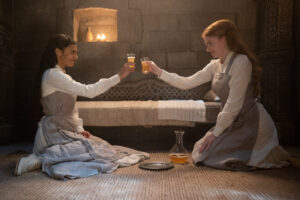
For Nynaeve, however, that’s the only time on the tour that’s not wasted. She has no interest in the Yellow Ajah as an organization, but the first time she ever consciously channeled was to Heal the Aes Sedai and Warders wounded, some almost mortally, by Logain in season one, and she channeled again to protect her friends in the Ways. Long before she knew what she could do, she was drawn to the life of a Wisdom, and never regretted sacrificing companionship for the privilege and honor of protecting the people she loves. The duties of the Yellow Ajah come closest to aligning with her own desires, and it’s only after seeing the work they do that Nynaeve starts seriously considering the Trial of the Arches. She makes up her mind after following Liandrin later that night (having clocked the Red sister stealing poisonous herbs from the hospital), and realizing that even the cold and emotionless Aes Sedai have people in their lives besides their equally enigmatic Warders they would do anything to protect.
Liandrin’s happens to be her son, a man about eighty or ninety years of age, whose long-overdue expiration she has staved off with toxins that Nynaeve warns her will only cause him more pain. We don’t know what the Tower would do about it if they found out, but we can reasonably assume (and Nynaeve certainly does) that a lot of Liandrin’s more…questionable choices are the result of trying to hide her precious boy and keep him alive as long as possible, at least until she finds something else worth living for. How far will Liandrin go for her son, and who will get hurt in the process? That question has been answered in the latest episode, but I wouldn’t dare spoil it for those who haven’t watched yet. The long, tumultuous, and often uncomfortable emotional journey viewers will take alongside Kate Fleetwood’s Liandrin, for whom you can’t help but feel a begrudging form of admiration and respect despite all the writing on the wall telling you not to trust a single word that leaves her permanently pursed lips, is something you must experience for yourself – and if, by the end of it, you don’t understand why I am adamant that Fleetwood deserves an Emmy nomination for her work here, well, I can’t change your wrong opinion but know that I will judge you for it.
Seemingly central to Liandrin’s schemes is Mat Cauthon (Dónal Finn), whom we learn has been imprisoned at the Tower for months now, but is digging an escape-route through the wall of his cell that eventually leads him to…an adjacent cell. Disappointing for him, but great for us viewers, because it facilitates a meeting between Finn’s Mat, who has a genuine warmth and sense of humor that Barney Harris, in my honest opinion, lacked, and Kae Alexander’s Min Farshaw, a charismatic bartender born with the unenviable ability to see pieces of the Pattern like images attached to people – sometimes cryptic, sometimes frighteningly clear. Mat has refreshingly little interest in learning his fate, however, and Min has no inclination to tell him what she sees; a vision of him stabbing Rand with the cursed dagger from Shadar Logoth, something that has no precedent in the books. Whether you interpret it as platonic, romantic, or playfully erotic, the palpable chemistry between these two is no joke (personally, I want them to kiss before the end of the season, but that’s just me).
Mat’s approach to life is to pretend he’s dodged the weavings of the Wheel of Time entirely, and to avoid looking too long at his own reflection, which would show him he’s bound up in threads of the Pattern as tightly as a fly in a spider’s web. The confidence he gains from thinking that only strengthens his resolve to escape the White Tower dungeons, but leaving the confines of his cell is exactly what the Wheel expects of him and has taken into account already. He can’t escape, not really; no one can. And if he and the other four ta’veren have it especially bad, they are not alone in feeling helpless. Moiraine, once the most self-assured character on the show, is trying to come to terms with the fact that, at this critical juncture, she’s expected to do something not in her nature and surrender to the will of the Wheel. She’s seen the threads that bind her; seen even further, all the way to the brink of the abyss where she’s being pulled, swiftly and inexorably. She’s prepared for that. What she can’t cope with is the thought of anyone being dragged down with her, because of her.
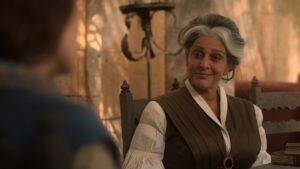
And thus we come to the most painful scene in the episode, in which Moiraine dismisses her Warder, al’Lan Mandragoran (Daniel Henney), after nearly twenty years of service. It’s for his own safety, which he can’t bring himself to comprehend through anger and frustration, but Moiraine doesn’t tell him that, or try to assure him of anything. She’s very much like Rand in that way. They are both extremely protective of the people they love, and see themselves as inherently unworthy of receiving that same love and protection in return because anyone close to them is in danger of being hurt, possibly by their own hand. When Moiraine tells Lan they “were never equals”, Lan interprets it one way but Moiraine, I think, phrased it as she did specifically so she could lead him to a conclusion at odds with the truth: that in her eyes, she was never deserving of his loyalty, because for as long as she’s known Lan her only purpose in life has been to serve and protect the Dragon Reborn, and, as was pointed out to her by the alarmingly perceptive Verin Mathwin (Meera Syal), there is no telling who she’ll have to hurt or kill to help the Dragon achieve his victory over the Dark One at the Last Battle. She knows she can’t bring herself to hurt Lan and that he would all too willingly sacrifice himself if it were ever necessary, so rejecting him is the only option left to her.
The unfortunate consequence of this choice is that it sets up an aimless subplot with Lan and Alanna Mosvani (Priyanka Bose), the Aes Sedai to whom Lan is handed for safekeeping like a parcel by Moiraine, that begs for a swift resolution. Alanna’s sensuality and apparent openness juxtaposed with Lan’s stoicism and silence could have provided insight into both their characters as well as entertainment, but I feel that The Wheel Of Time is perhaps focusing too hard on establishing Alanna before it has the need, or the ability to do anything particularly meaningful with her. Until Lan inevitably returns to Moiraine (and, short of killing him herself, which she will never do, there is nothing she can do or say to prevent that from happening one way or another, because the Wheel has willed it), this storyline was bound to drag – but we will discuss that in greater detail another time.
The philosophical questions raised in episode two are unlikely to be definitively answered in our lifetimes, much less in this season of The Wheel Of Time, but the speculative answers put forward in the pages of Jordan’s books offer arguably less comfort than the uncertainty we endure. In the world he envisioned, certain events must happen and ultimately will happen in every Age for as long as the Wheel keeps turning, but they cannot happen on their own, therefore requiring that the people statistically most likely to make the “right” choices are spun out into the Pattern at the “right” time to ensure said choices will be made, as anything else could potentially lead to the breaking of the Wheel and the dissolution of the Pattern.
This would be bad, we’re meant to understand, because no one’s choices would have any meaning then. But what meaning does a choice actually have, if the Wheel only allows those that either directly serve its goal or have no consequence, and can spin out ta’veren to “correct” the rest? What meaning is there in the Wheel itself, if it wants nothing, works toward nothing, achieves nothing in any Turning except its continued self-preservation? If humanity can never advance so far that all their progress can’t be reversed in the next Age, all their accomplishments reduced to the stuff of legends? If the so-called Last Battle between the Dragon and the Dark One only acts as a catalyst for further upheaval, and all the blood shed, all the tears spilled, all the sacrifices made by our protagonists, not only won’t prevent it from happening again, but rather, ensure it will? Is the promise of rebirth any comfort, if the world into which you’re reborn is still fighting the same war you fought in all your previous lives?
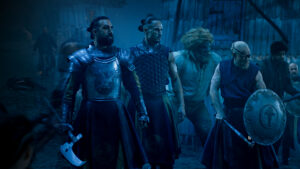
I don’t mean to burden my readers with these and other questions that keep me up at night wondering what Jordan potentially found soothing in this unique interpretation of the cosmos, and I’m not trying to parrot the Dark One’s own talking-points (breaking the Wheel is his only solution to everything, and while it sounds revolutionary on paper, in practice, it would achieve nothing), but these are questions which The Wheel Of Time‘s writers should spare some further thought, seeing as they’ve expanded on Jordan’s themes in countless ways already and always with a care and consideration for the essence of the source material coupled with a desire to be forward-thinking that makes me genuinely interested in what they have to say through the retelling of this particular story. I’m not saying the protagonists should necessarily break the Wheel by the end of the series; I just think there are a lot of shapes that time could take and something as simple as adjusting it to a…Straight Line of Time, for instance, would solve a lot of this world’s problems.
Episode Rating: 8.5/10
